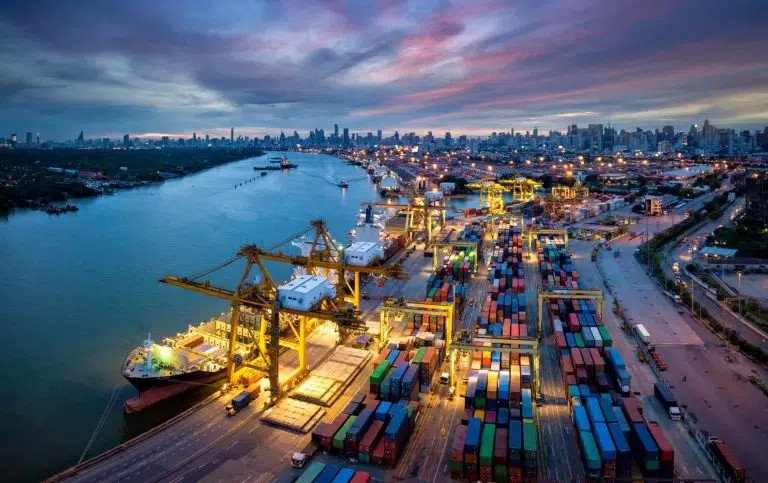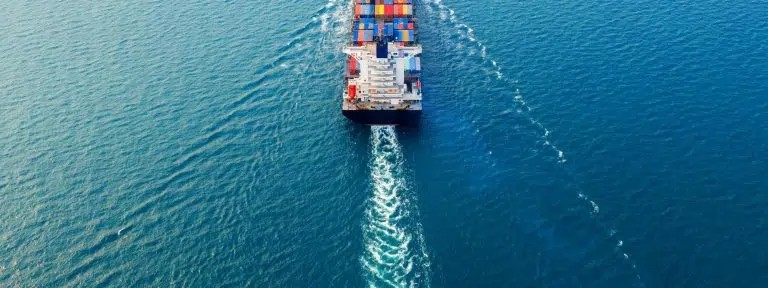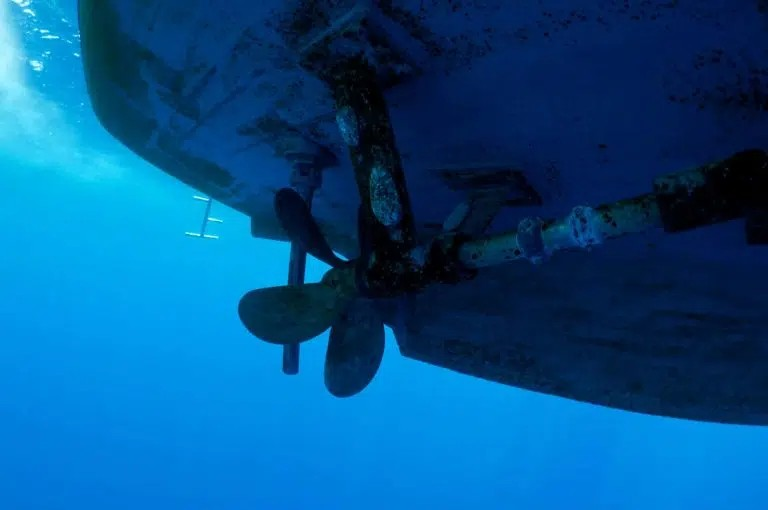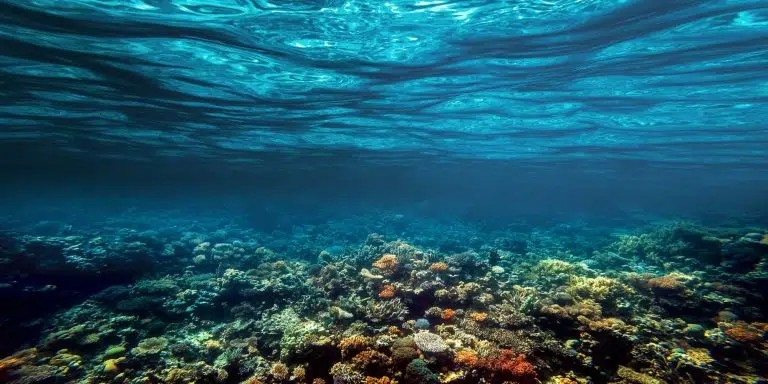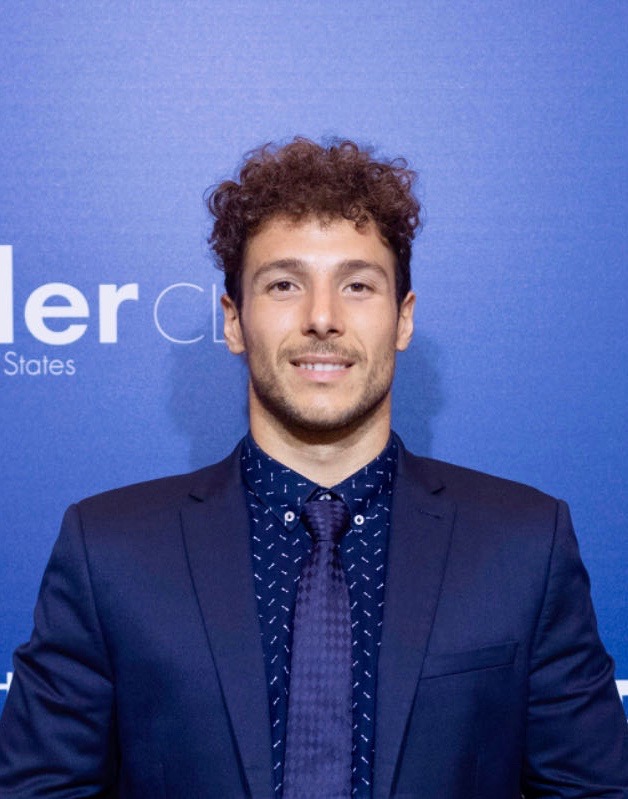Cruise Decarbonization Strategy from V.
The shipping sector is crucial for international trade (~80–90% of global trade occurs through shipping) and hence vital to the world economy. Furthermore, cruise ships, ferries and yachts are an important part of the world’s tourism industry.
Due to the scale of the sector, shipping represents ~3% of the total global greenhouse gas (GHG) emissions, therefore strict environmental regulations around carbon emissions are set to cause major technological changes in the industry.
In light of shipping decarbonization, Ship Nerd News interviewed specialists from V. about their approach and goals for a greener future. V. provides services to more than 3,500 vessels, of which over 100 are cruise ships, yachts, and ferries. These services include technical management, hotel management, crew management, manning, catering services, new building supervision and insurance.
Mr. James Helliwell (V. Group Decarbonisation Manager) and Mr. Ilias Bougas (V.Ships Leisure Business Development Manager) see a very positive outlook for the global cruise market, with many cruise lines ordering new ships along with the entry of new brands and technologies. They assure that third-party management remains an attractive option for start-ups but also for cruise lines looking to leverage their global network and scale. In combination with the marine services division, V. can also offer hybrid solutions where an owner can manage in-house, whilst leveraging the operating platforms.
V Group
V. Ships Leisure Decarbonization
1. Overview
What is your current cruise decarbonization strategy and its main objectives?
At V., we have committed to reach net zero by 2050. To help achieve this, V. has joined the Maersk Mc-Kinney Moller Centre for Zero Carbon Shipping (MMMCZCS). Note that V. is the only ship management company within this group. V. is working with partners at MMMCZCS in the research and development centre for the next generation of solutions to help the maritime industry decarbonise. V. has formed a strategic partnership with Aither, which provides carbon trading solutions for shipowners and other industries, focused on the seamless trading of carbon credits for the EU Emissions Trading System (ETS) scheme and beyond, benefiting shipowners with vessels managed by V.
2. Hydrodynamic Improvements & Innovative Technologies
What hydrodynamic improvements are being implemented to enhance efficiency?
Arguably one of the most important hydrodynamic improvements to support a vessel and enhance its energy efficiency is proper management of the condition of the hull and propeller. Keeping the hull and propeller clear of biofouling can lead to a significant reduction in fuel consumption and emissions. One feature of V.ERDE (Vessel Emission Reduction Decarbonisation Enhancer – a digital solution of V.) assesses the performance of a vessel and advises the most optimum time to clean the hull or propeller to help the vessel remain fouling-free.
Technologies like air lubrication and propulsion devices like Propeller Boss Cap Fins (PBCF), Pre Shroudded Vanes (PSV) Ducts and High-Efficiency Propellers (HEP) also appear promising for cruise vessels, depending on the operating profile of the vessel. SeaTec, part of V., supports owners in such cases with technical design, consultancy and installation of these technologies on behalf of cruise operators.
V Group
How do these improvements impact fuel consumption and emission reduction?
Over time, marine organisms accumulate on the hull of a ship, increasing drag and resistance as the vessel moves through water. Regular hull cleaning removes this biofouling, thereby reducing the friction between the hull and water. By maintaining a clean hull, we can achieve fuel savings of up to 10%, significantly cutting down on CO2 and other emissions. Propeller polishing involves smoothing the propeller surfaces to reduce roughness caused by corrosion and marine growth. A polished propeller operates more efficiently and can contribute to fuel savings of approximately 3-5%, helping us lower our carbon footprint.
Air lubrication systems create a layer of micro-bubbles along the bottom of the hull, reducing the friction between the hull and water. By reducing the energy required to propel the ship, air lubrication can result in fuel savings of up to 8%. Finally, PBCF technology improves propeller efficiency by mitigating the energy losses associated with the hub vortex created by the rotating propeller. PSV Ducts correct the flow into the propeller which essentially reduces the rotational losses in the propeller slipstream and increases the flow velocity towards the inner radius of the propeller. The increased propulsion efficiency from PBCFs, PSV Ducts and HEPs can lead to fuel savings of around 9-12%.
Which innovative technologies are being adopted by the cruise industry?
V. has significant experience in retrofitting solutions to help vessels reduce their environmental impact. Air lubrication and carbon capture are two technologies particularly suited to cruise vessels. We support cruise operators with retrofitting solutions of these technologies. Given the substantial height of cruise vessels, wind technology is seen as less suitable for the leisure market as wind technologies can pose restrictions to the air draft of the vessel, limiting access to ports with low bridges.
V Group
Can you share any innovative technologies or practices utilized to improve energy efficiency?
In addition to air lubrication and carbon capture, vessel power management optimisation is an important part of decarbonizing a cruise vessel. The hotel load of a cruise vessel is a significant contributor to the vessel’s total emissions. Intelligent automation systems which switch off lighting and air conditioning systems in spaces when not in use can lead to a significant reduction in emissions. V. evaluates the vessel energy consumption to identify opportunities to reduce emissions with intelligent automation.
To what extent are routing optimization and AI incorporated in the vessel’s operations?
V. has launched V.ERDE. This solution combines digital performance analysis of vessels with dedicated support from experts in the group to help vessels decarbonize. Through V’s V.ERDE platform, AI is being used to create the next generation of route optimisation solutions which will launch later in 2024. In addition, AI is being used to help support the fleet in managing the enormous amount of data available in our proprietary, digital operating platform (ShipSure), helping vessel managers make informed decisions that improve vessel operations on the insights found in the data.
V Group
3. Alternative Fuels & Propulsion Systems
Is V. exploring alternative fuels such as LNG, biofuels, or hydrogen? If so, what are the challenges and benefits associated with these alternatives?
Through V’s involvement with the MMMCZCS, we are working with partners to lead the industry in researching the next generation of fuels. For example, V. is leading a human factors assessment of the risks of ammonia to vessel crews. The toxicity of ammonia is a major challenge, with significant research required to design systems that help reduce this risk. In the shorter term, V. is focused on more mature solutions to help reduce emissions. For example, V. is the technical manager of a fleet of LNG carriers and LNG dual-fuelled vessels, as well as the technical manager for methanol dual-fuelled tankers. LNG and Methanol have a lower greenhouse gas intensity than heavy fuel oil, helping the industry to take the first step in reducing emissions. V. is also ensuring its seafarers are ready for the future, with dedicated training on new fuel pathways, including ammonia, methanol and LNG.
Are there plans to invest in new propulsion systems, such as electric, hybrid, nuclear engines or Fuel Cells?
V. is investing in its people to build the knowledge and experience to support and guide ship owners, who might be considering making investments in new propulsion systems. Through V’s collaboration with partners in the MMMCZCS, we have published groundbreaking research on the application of fuel cell systems for deep-sea shipping. We are also investing heavily in training, with dedicated courses focusing on new fuels and the technologies required to handle them.
V Group
4. Regulatory Compliance & Industry Standards
What role do regulatory bodies play in shaping your cruise decarbonization strategy?
Regulatory bodies play a crucial role in shaping our cruise decarbonization strategy at V. Their guidelines, standards, and regulations provide a structured framework within which we operate, driving our commitment to sustainability and environmental responsibility. The International Maritime Organization (IMO) set ambitious emission reduction targets for the maritime industry. For example, the IMO’s strategy to reach net zero by around 2050 is a significant driver of our long-term cruise decarbonization goals. These targets provide a clear direction for our sustainability initiatives and compel us to adopt best practices and innovative technologies. The IMO’s 2020 sulphur cap, which limits sulphur content in marine fuels to 0.5%, is a great example of how regulatory compliance ensures that the industry works together to reduce its ecological footprint.
Various regulatory bodies and governments also help to provide financial incentives, grants, and subsidies to support the adoption of green technologies and sustainable practices. For example, the new FuelEU Maritime regulation introduced by the EU helps to provide a mechanism that closes the cost gap between conventional fuels and new lower-carbon fuels. Penalties charged through the scheme are then reinvested to the industry through grant funding, helping owners to invest in modifications to vessels to adopt these new fuels. Finally, regulatory requirements for monitoring, reporting, and verification of emissions ensure transparency and accountability in our operations. Adhering to these requirements helps us track our progress, identify areas for improvement, and demonstrate our commitment to sustainability to stakeholders. Accurate and transparent reporting builds trust and reinforces our reputation as a responsible maritime operator.
How is V. Ships Leisure preparing for compliance with the FuelEU Maritime framework?
V. Ships Leisure is fully prepared for the upcoming FuelEU Maritime regulation. Our teams are hard at work preparing the monitoring plans that are required to be submitted before August 31st. Later this year, V. will launch a digital service, part of its V.ERDE platform, to gather the necessary data and submit emissions reports to our appointed verifier. V. is also actively exploring options to support owners who are interested in joining pooling solutions.
What specific measures are being taken to meet the requirements of the FuelEU Maritime regulations?
At V., we are proactively addressing the requirements of the FuelEU Maritime regulations. To comply with these regulatory requirements, we are implementing a range of specific measures, including (as mentioned above):
⦁ Alternative Fuels
⦁ Energy Efficiency Improvements
⦁ Digitalization and Data Analytics (Digital solutions provided through our V.ERDE platform)
⦁ Robust monitoring, reporting, and verification systems to ensure compliance
V Group
5. Collaboration & Partnerships
Are there any notable collaborations or partnerships with other industry stakeholders to advance decarbonization?
V. is the only ship manager within the MMMCZCS, and we are collaborating with partners in this group to advance decarbonization and mature lower-carbon fuel solutions. V is part of the UK Chamber of Shipping decarbonisation and alternative fuels working groups, helping to prepare specific guidance for the adoption of lower carbon fuels, whilst also helping to shape the next generation of decarbonisation regulation. V. is also part of BIMCO and Intermanager working groups preparing agreements that support the adoption of FuelEU.
How do these partnerships contribute to achieving your cruise decarbonization goals?
Our partnership with the MMMCZCS is a pivotal element in our strategy to achieve our ambitious cruise decarbonization goals. This collaboration harnesses the combined expertise, resources, and innovative capabilities of a leading industry consortium dedicated to accelerating the maritime sector’s transition to zero-carbon operations. Here’s how this partnership specifically contributes to our cruise decarbonization efforts:
We collaborate to develop cutting-edge research and development initiatives focused on sustainable maritime technologies. V’s participation in this research gives our owners access to the latest research. One of the Centre’s core focus areas is the development and deployment of alternative fuels such as green hydrogen, ammonia, methanol, and biofuels. Collaborating with the Centre enables us to stay at the forefront of innovation, ensuring that we are prepared to transition to low-carbon and zero-carbon fuel options as they become commercially viable.
The Centre actively engages with regulatory bodies and policymakers to advocate for supportive regulations and incentives for cruise decarbonization. Our partnership with the centre and other bodies like the UK Chamber of Shipping, BIMCO and Intermanager allows us to contribute to these advocacy efforts, ensuring that the regulatory environment facilitates and accelerates our sustainability initiatives.
Our partnerships provide us with the resources, expertise, and collaborative opportunities needed to drive meaningful progress towards a sustainable future for the maritime industry. Together, we are charting a course towards zero-carbon shipping, demonstrating our commitment to environmental leadership and innovation.
V Group
6. Monitoring & Reporting
What metrics are used to measure success?
The Carbon Intensity Index (CII) of each vessel in our fleet is a key metric, and we report this monthly in our ESG updates. The CII rating is an A to E rating system introduced by the IMO, with the most energy-efficient vessels given an A rating. Vessels that are E rated in any given calendar year or a D rating for 3 years must make improvements to increase energy efficiency. About 80% of V’s fleet is currently rated A to C.
Is there any platform/ecosystem for monitoring and optimization being adopted or will there be in the future?
V.ERDE allows vessel owners to track the performance of their vessels and identify opportunities to reduce fuel consumption. The tool includes features for monitoring the vessel’s compliance with regulations such as FuelEU and EU ETS. It includes solutions for route optimization and engine performance monitoring. As noted above, V. has also partnered with Aither, allowing owners to share their data and procure the carbon credits required to comply with EU ETS.
7. Challenges & Opportunities
What are the biggest challenges V. Ships Leisure faces in its cruise decarbonization journey?
The main challenges the industry faces on the cruise decarbonization journey are:
Technology Maturity – There have been significant advances recently in the development of green technologies, including alternative fuels (LNG, hydrogen, ammonia), energy-efficient ship designs, and carbon capture systems. Adopting and integrating these technologies into the existing fleet is a complex and capital-intensive process. The industry faces challenges in ensuring that these technologies are not only effective but also safe and reliable for large-scale, long-term operations.
Infrastructure Development – The transition to alternative fuels requires substantial changes in port infrastructure and supply chains. Establishing bunkering facilities for alternative fuels, retrofitting ships for new fuel types, and developing shore-side power connections are all necessary steps. The lack of standardized infrastructure across global ports poses a significant logistical challenge.
Regulatory Compliance – The regulatory landscape for cruise decarbonization in the maritime sector is continually evolving, with varying requirements across different jurisdictions. Keeping abreast of these regulations and ensuring compliance is a significant task. We must navigate the complexities of international, regional, and national regulations while striving to exceed these standards.
Operational Considerations – Implementing energy efficiency measures and alternative propulsion systems without compromising the safety, reliability, and performance of our cruise operations is a delicate balance. Crew training and adaptation to new technologies and practices are vital components of this transition.
V Group
What opportunities do you see arising from the shift towards a more sustainable cruise industry?
Cruise Decarbonization presents many exciting opportunities, including:
Innovation and Technology – The drive towards sustainability accelerates the adoption of cutting-edge technologies. Innovations in alternative fuels, energy-efficient ship designs, and advanced propulsion systems create opportunities to enhance our operational efficiency and reduce our carbon footprint.
Operational Efficiency – Implementing energy-efficient measures and optimizing vessel operations can lead to significant cost savings. Reduced fuel consumption, improved maintenance practices, and streamlined operations contribute to lower operational costs over time. These efficiencies help the industry to shift towards a more sustainable future.
Talent Attraction and Retention – A commitment to sustainability resonates with the values of many employees, particularly younger generations. Embracing sustainable practices can help attract and retain top talent who are passionate about making a positive impact on the environment. A motivated and engaged workforce is crucial for driving innovation and achieving our sustainability objectives.
Collaborative Partnerships – The shift towards sustainability fosters collaboration across the maritime industry. Partnering with technology providers, research institutions, and other stakeholders allows us to share knowledge, pool resources, and drive collective progress. These partnerships can lead to breakthroughs in sustainable practices and technologies that benefit the entire industry.
Long-term Resilience – Investing in sustainability enhances our long-term resilience and adaptability. As the global economy increasingly prioritizes environmental sustainability, being at the forefront of this shift ensures that the cruise industry is well-positioned to navigate future regulatory changes, market dynamics, and stakeholder expectations.
8. Future Outlook
What are your long-term goals for cruise decarbonization, and how do you plan to achieve them?
At V., our commitment to environmental sustainability is at the core of our business. We have set the goal to achieve net zero carbon emissions by 2050. To realize this goal, we have outlined a comprehensive strategy encompassing various key initiatives and milestones:
Services for the adoption of Green Technologies – through our subsidiary SeaTec, we help owners with the design and management of green technologies to significantly reduce their carbon footprint and increase operational efficiency.
Optimizing Operational Practices – Improving our operational efficiency is essential for reducing emissions. Through our V.ERDE digital platform, we are implementing advanced data analytics and digital tools to optimize voyage planning, speed management, and fuel consumption.
Collaborative Research and Development – We are partnering with MMMCZCS to drive innovation in sustainable maritime practices. Developing breakthrough technologies and solutions that can accelerate our journey towards net zero.
Regulatory Compliance and Leadership – We are committed to meeting regulatory requirements and setting industry benchmarks for sustainability. By staying ahead of evolving regulations and actively participating in industry forums, we aim to shape the future of maritime decarbonization and promote best practices across the sector.
Stakeholder Engagement and Transparency – Engaging with stakeholders, including customers, investors, regulators, and local communities, we commit to maintaining transparency in our sustainability efforts by regularly reporting on our progress and milestones. Building trust and collaboration enhances our ability to achieve our long-term goals.
Employee Training and Culture – We are investing in training and development programs to equip our employees with the knowledge and skills needed to support our cruise decarbonization initiatives.
Alexandros Lampoglou
Ilias Bougas
James Helliwell
How do you envision the environmental future of the industry?
We are already seeing a new generation of cruise vessels entering the market fuelled by lower-carbon LNG. The shift to LNG has already shown that the industry can begin to change its fuel behaviours to help it reduce its overall carbon footprint. In the short term, we predict vessels using drop-in biofuel replacements for existing fuels. For example, biodiesel and biogas are drop-in replacements available today for fuel oil and LNG-fueled vessels. FuelEU Maritime coming into effect in 2025 will likely accelerate the adoption of biofuels. We then foresee the industry continuing this trajectory, with new vessel designs operating on lower carbon fuels like methanol and hydrogen in the medium term.
We also foresee a continued increase in the level of automation, powered by advances in AI, to help further reduce the fuel consumption of vessels. This will include more advanced control of technologies like air lubrication, to optimize the technology to get the most out of its performance. AI will also drive further advances in accommodation design, with smart features to minimize power consumption and drive efficiency improvements.
Conclusion
While the regulatory bodies are pushing cruise decarbonization with ambitious targets, guidelines, standards, and regulations, V. has taken various measures and actions to be on the front line. From the hydrodynamic improvements of hull cleaning and Energy Saving Devices installation which are now considered fundamental to the development of AI-driven V.ERDE platform which assists the vessel operator to ensure performance optimization. Additionally, V. is involved in strong partnerships such as MMMCZCS to expedite even more the transition to alternative fuels.
We would like to thank Mr. James Helliwell and Mr. Ilias Bougas for sharing their invaluable insights and detailed plans for a more sustainable future.
Don’t miss news, updates and reviews on the world of cruises on Cruising Journal.

